Analysis
The Key to CTV Success Could Already Exist in Your Social Video Strategy
by Jacob Trussell11 min read
Abstract
- Connected TV has brought performance strategies to the living room screen
- QuickFrame and Digiday’s 2022 report on social media video tactics provides insights that can be applied to CTV campaigns.
- Advertisers and marketers alike can use the report’s findings to adapt effective social media strategies to enhance performance on CTV.
Even if you’ve never produced a TV commercial before, chances are that you’ve created more than your fair share of social media ads.
When developing creative for a Connected TV campaign, social ads can serve as an excellent starting point. Social media campaigns, like search, rely on performance-based strategies that provide valuable analytical data on creative performance. Advertisers can use social campaigns to identify the kinds of language and visuals that will resonate with audiences, then develop CTV ad creative based on that data.
However, with CTV now established as a true performance channel, marketers can leverage social media ad strategies for more than just creative insights. TV advertising campaigns are now operating much like social campaigns, giving marketers new ways to analyze performance and optimize their campaigns.
To demonstrate how social strategies can be applied to CTV campaigns, we analyzed a study conducted in the fall of 2022 by QuickFrame by MNTN and Digiday. The study surveyed marketers on their social video strategies in key areas, including creative production, measurement, and optimization.
By applying these strategies to CTV campaigns, brands can improve their targeting and creative approach, ultimately driving better results.
The State of Social Media Video Marketing: Methodology
The 2022 report produced by QuickFrame and Digiday explores how marketers are strategizing their social media advertising campaigns with a focus on video content, as well as their efforts to combat ad fatigue.
Drawing insights from industry experts as well as a survey of 120+ agencies and brands, the report showcases the methods teams are using, the adjustments they’re making to their media mix, and how they’re planning for future campaigns.
Let’s explore three key areas where marketers can translate social media strategies for producing, deploying, and optimizing ad creative to their CTV campaigns.
1. Pre-Production Strategies
Pre-production is arguably the most vital stage of the video production process. It’s when concepts are formed, copy is written, and shots are planned. It’s also when you identify which platforms you want to target so you can properly formulate a budget, which dictates how many assets you can ultimately generate.
What the report found
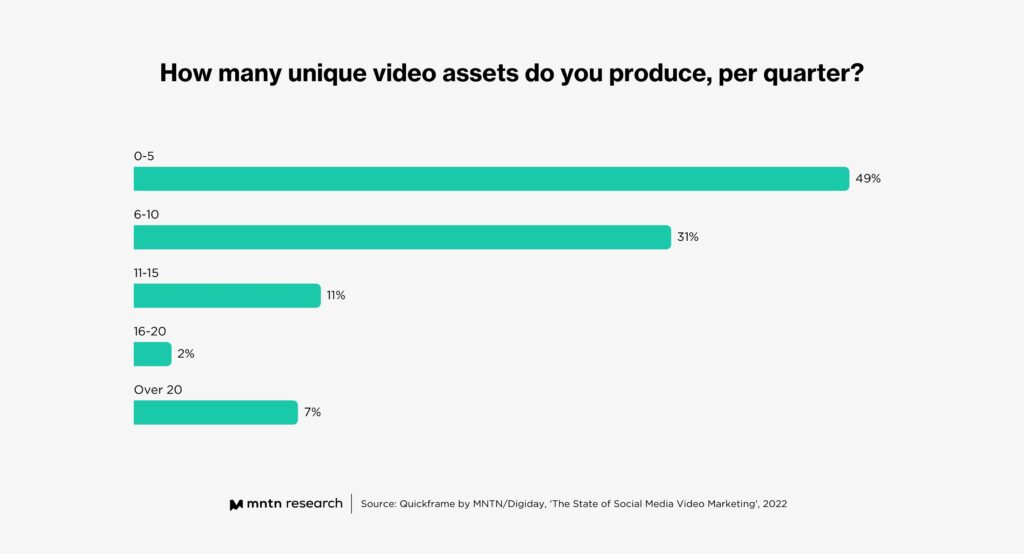
According to the survey, nearly half of respondents said they produce zero to five unique assets per quarter, while 20% indicated that they create 11 or more assets during the same period.
This suggests that many marketers aren’t creating social videos at scale, which directly impacts their performance strategies. Whether it’s in a social or CTV campaign, it’s more difficult to drive effective performance with only a handful of assets. A higher volume of videos gives marketers more opportunities to refine creative, like swapping out opening hooks or call-to-actions, to improve performance as it begins to drop.
To maximize the performance capabilities of CTV and move beyond simple reach, it’s crucial to focus on producing more creative assets every quarter rather than less. By doing so, you can take full advantage of the platform’s potential and drive better results for your brand.
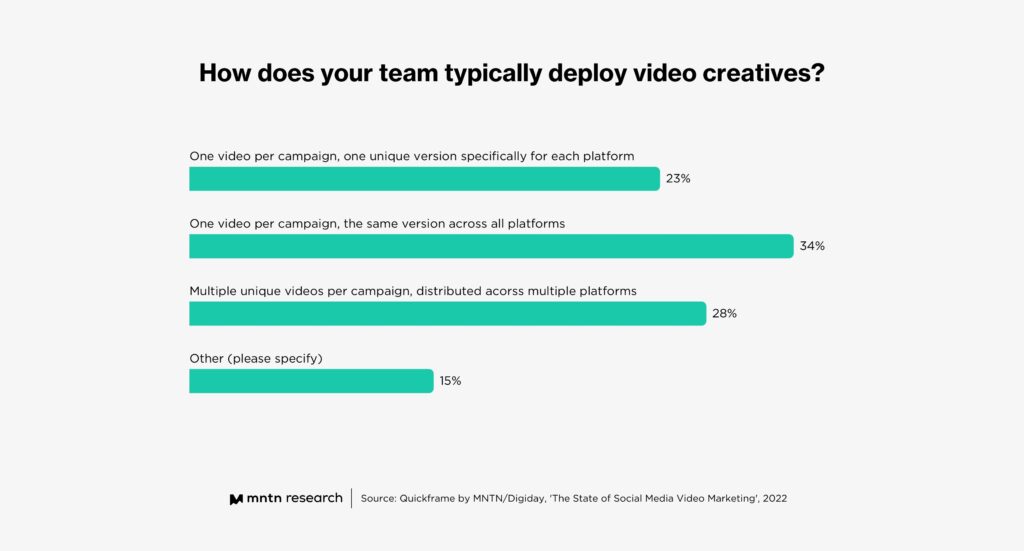
But that’s a lesson marketers are clearly still wrapping their heads around on social media. When asked how their teams deploy video creative, more than half of respondents said they’re producing only one video per campaign (although nearly a quarter of them create variations of the same video for each platform). Only 28% are implementing the smarter strategy: creating multiple unique videos per campaign to distribute across multiple platforms.
Sure, unlike social media, marketers only have one platform to focus on with CTV. But they’ll be doing their best impression of Sisyphus if they’re only producing one or two videos for a performance-focused CTV campaign.
Like we mentioned, the more effective strategy for performance is to produce multiple variations of your ad creative. We get it—producing a higher volume of videos can feel like a significant challenge, especially for smaller marketing teams with limited resources. But the lift isn’t as heavy as it may seem, as you can co-opt strategies for crafting creative on social media and replicate them for CTV campaigns.
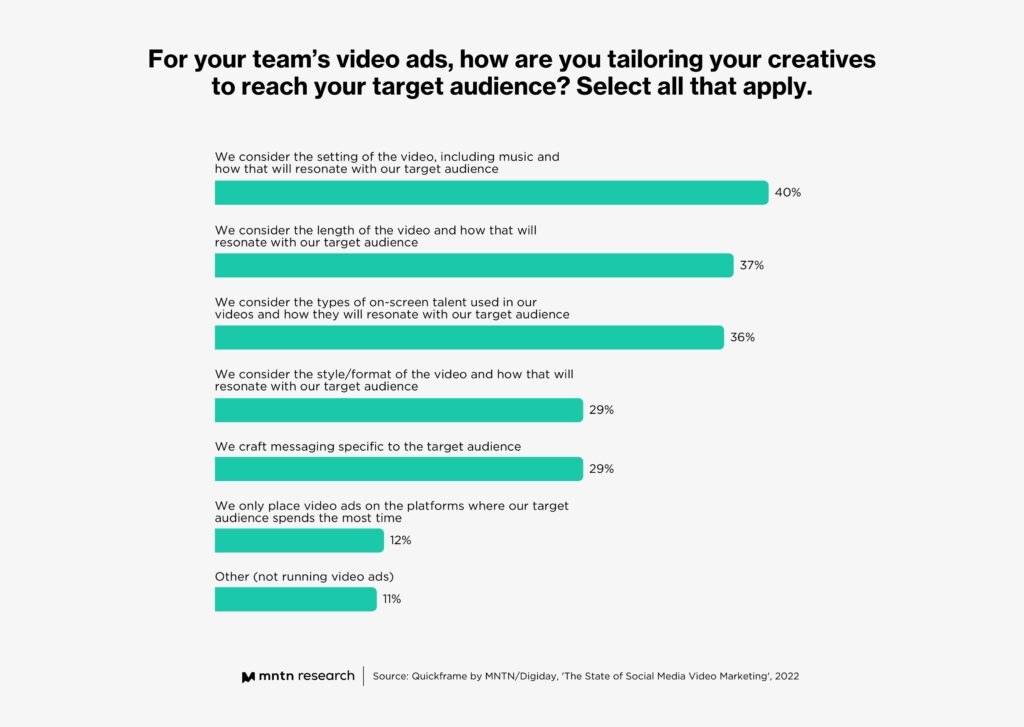
Borrowing tactics from the land of social media can help marketers streamline how they produce their CTV creative. When surveyed on how marketers tailor social ads to specific audiences, respondents’ top considerations were the setting, length, talent, and video styles. These considerations can essentially be used like a pre-production checklist for CTV ads, providing a solid foundation of approaches marketers can refine and build upon. For instance, which on-screen actors are likely to resonate loudest with your target audience? Is there a particular type of format they’re already engaging with on social media — user-generated content, unboxing videos, creative animation — that you can adapt for TV?
Using this data, brands can gain insights into what their audience is already craving and use it as a starting point for crafting better creative. With a more tailored approach, CTV campaigns can be optimized for maximum performance, driving better results and creating a more engaging experience for viewers.
2. Measuring Performance
Picture this: you’ve just spent weeks crafting and distributing a campaign. You know in your gut it’s going to achieve your objectives but (shocker!) your VP wants statistical proof that it was the creative strategy—not dumb luck—that delivered on your performance goals.
(What can we say? C-suites love themselves some cold hard stats.)
In today’s age, it’s so much easier to provide that data, as marketers now have more measurement tools—from Google Analytics to MNTN’s Performance TV platform—to connect the dots between the creative and the performance that it delivers.
If brands want to make the most informed decisions possible about their creative strategies, evaluating and monitoring performance metrics are absolutely essential to gain valuable insights and refine future campaigns.
What the report found
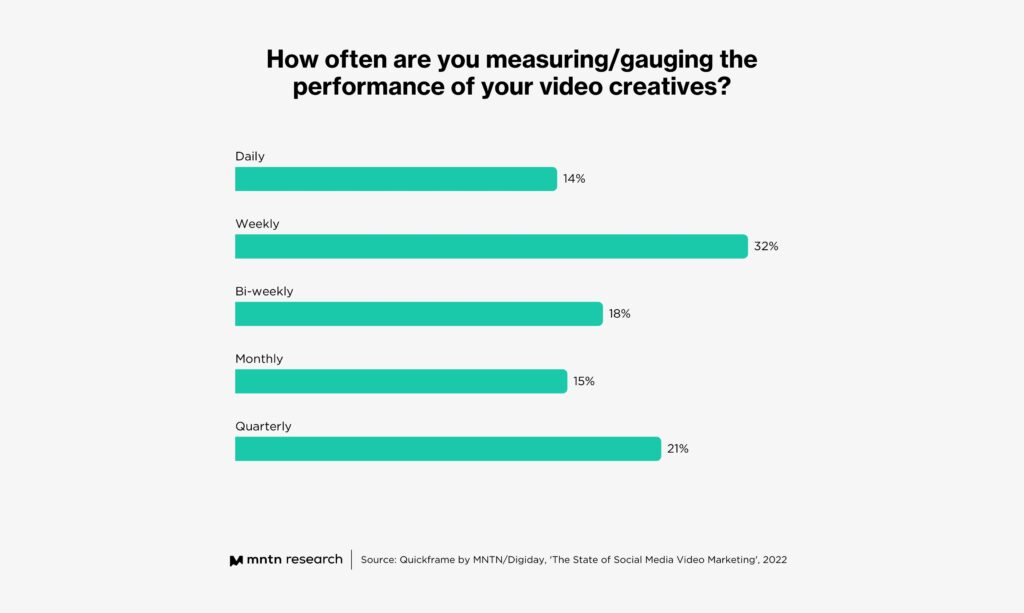
This part of the survey results is music to our ears, as it highlights precisely what brands should be doing with their performance strategies on CTV. After initially launching a campaign, we recommend giving it a few days to generate data before you can most accurately measure its effectiveness. However, once the ad is generating results, it’s crucial to audit performance on a weekly (or even daily) basis. This enables brands to track dwindling performance the moment it happens, allowing them to make agile creative moves and avoid the risk of their audience getting tired of seeing the same ad repeatedly.
By keeping a close eye on a campaign’s performance metrics and making timely adjustments, brands can optimize their CTV campaigns for better results, keeping their audience engaged and driving better outcomes. This approach ensures that every ad shown to viewers is fresh and relevant, creating a better user experience and ultimately generating higher campaign performance.
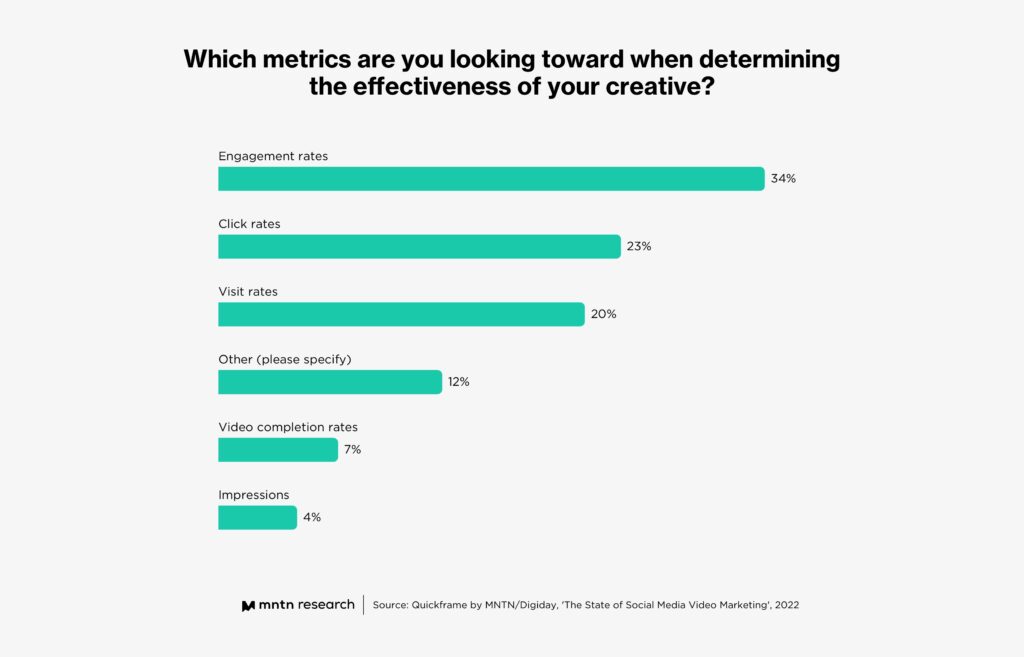
To properly measure your CTV ad campaign’s performance, you need to know which metrics to focus on. While engagement, click, and visit rates are crucial for social media campaigns, for CTV ads, one of the most significant and straightforward metrics to track is video completion rates. This metric measures how long a viewer watched your video, whether it’s just one second or a full minute. By keeping an eye on this metric, brands can determine how engaged their audience is with their narrative and whether the opening hook is resonating with them.
Once you understand video completion rates as a metric, concepting your CTV ad creative becomes that much easier. It allows you to tailor your messaging and creative approach to better capture your audience’s attention and keep them engaged throughout the ad. By analyzing this metric, brands can identify potential drop-off points and make adjustments to improve their ad’s performance. Kind of like how the quickest way to a salary increase in modern times is to just change jobs, the quickest way to positive performance is knowing when to change creative the moment viewers can’t bear to finish your commercial anymore.
3. Creative Refreshes
Ask any advertiser what their biggest ongoing challenge is. We’re willing to bet “ad fatigue” is in their top 5. Everyone gets sick of watching the same ad repeatedly, and that can spell trouble for any brand. If you continue to deliver the same ad over and over— think HeadOn’s infamous “Apply Directly to the Forehead” spot—your audience will become fatigued, and your message will lose its effectiveness.
That’s why creative refreshes are so valuable, especially if you plan for them during the pre-production stage. By swapping the creative with something new when you notice dips in performance, your campaigns remain fresh — and your audiences stay tuned in rather than zoning out.
This is particularly important on CTV because the platform isn’t scrollable and rarely allows skipping; viewers have to view multiple ads if they want to enjoy their favorite shows. While CTV advertising can result in higher ad recall, it can also lead to faster fatigue if the same ad is served too many times, which can lead to poor campaign performance, wasted media budget, and negative audience sentiment.
According to a study from QuickFrame by MNTN, video ad completion rates peak at five days, after which there is a daily decrease of 5% in delivery.
What the report found
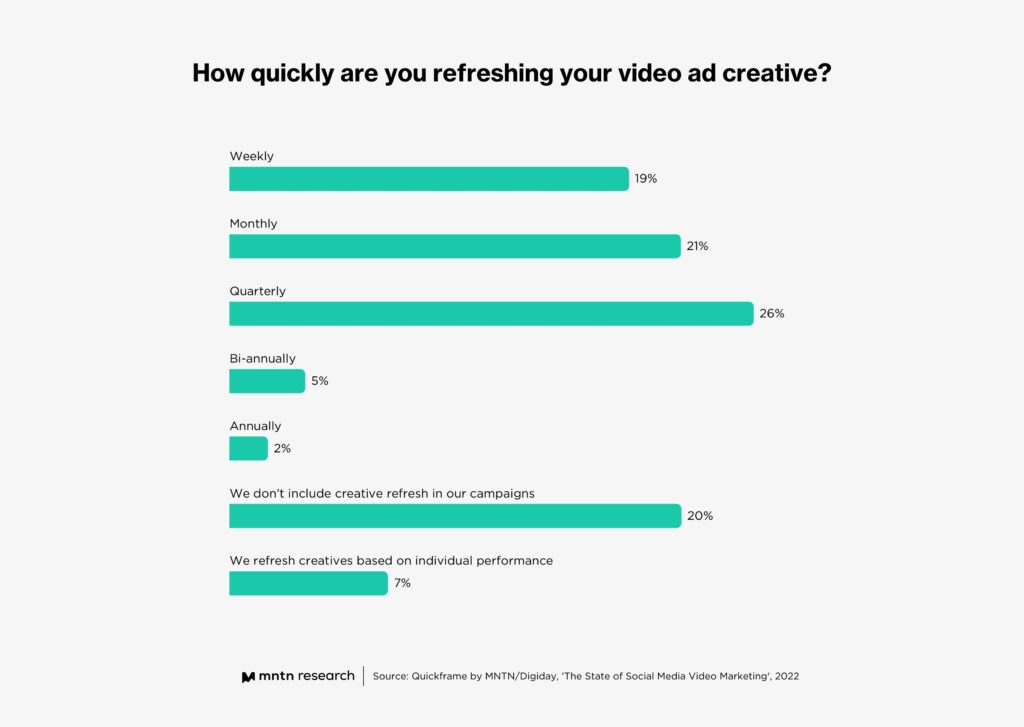
According to the QuickFrame and Digiday report, 40% of brands and agencies refresh their creative on a monthly basis — a comfortable cadence when optimizing campaigns mid-flight. Catching an ad the moment fatigue sets in allows for quick refreshing to boost performance metrics.
However, over half of the respondents in the survey indicated that creative refreshes are not a top priority for their brand or agency, with most opting for quarterly refreshes or not including refreshes in their campaign strategies at all. That can leave brands balancing on a razor’s edge, one oversaturated ad away from negatively coloring the overall perception of their business. You really can’t afford to become that brand who fills commercial breaks with ads viewers seemingly cannot escape.
We see you Kars for Kids. We. See. You.
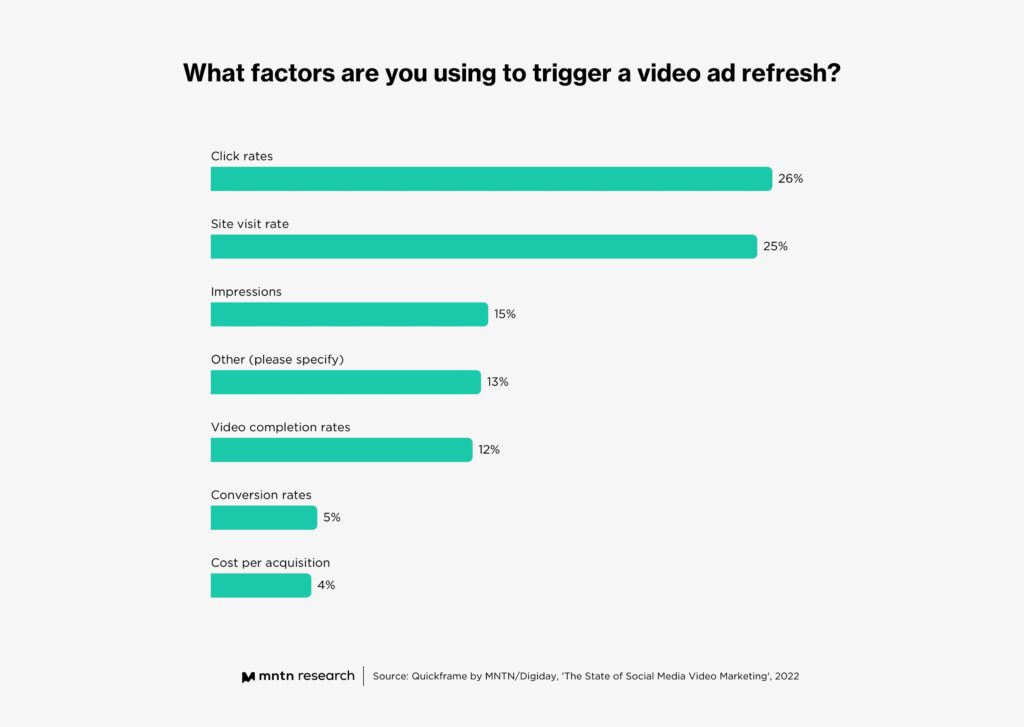
If this chart seems familiar, that’s because the factors that spark a creative refresh for CTV ads are similar to the metrics social marketers use to gauge ad effectiveness.
While click rates and site visit rates are important indicators that can tell marketers when a creative refresh may be necessary, for CTV ads, video completion rates remain the most relevant metric to track. If viewers are turning off their televisions or skipping the ad after just a few seconds, it’s a clear sign that it’s probably time for a refresh.
CTV is up-and-coming — but it still has much to learn from social
Back in the (g)olden days of advertising, TV commercials did exactly one thing: reached a vast audience through the living room screen with a 30-second message. It looked the same, felt the same, acted the same for everyone. But televisions aren’t just connected to component cables anymore—they’re hooked into the internet, giving marketers the ability to adapt performance strategies they may have used on social for Connected TV campaigns.
These changes have made the platform a premiere destination for brands of all sizes to reach new audiences and hit their performance goals, whether that’s driving app downloads or increasing conversion rates on their website. Ad-supported streaming services like PlutoTV and Hulu have only accelerated the growing popularity of internet-connected televisions as an advertising platform.
Analyzing how marketers approach video on social media can offer valuable insights for ideating, crafting, and deploying CTV creative. The learnings marketers cull from social can help inform everything from creative strategies to optimization and measurement tactics, providing a solid foundation for your first (or next) campaign.
So to paraphrase arguably the cheesiest quote from 90s cinema, TV advertising was once like a box of chocolates – you never knew what (performance) you’re gonna get. But now that the living room screen has transformed into a true performance channel, you don’t have to waste time wondering anymore if your ads actually drove results. You’re able to build your own ‘box of chocolates’ so you’ll know exactly what to expect inside.
Except, you know, for performance (and not coconut-flaked truffles.)
Subscribe to the MNTN Research Weekly
Sign up to receive a weekly feed of curated research, sent straight to your inbox.